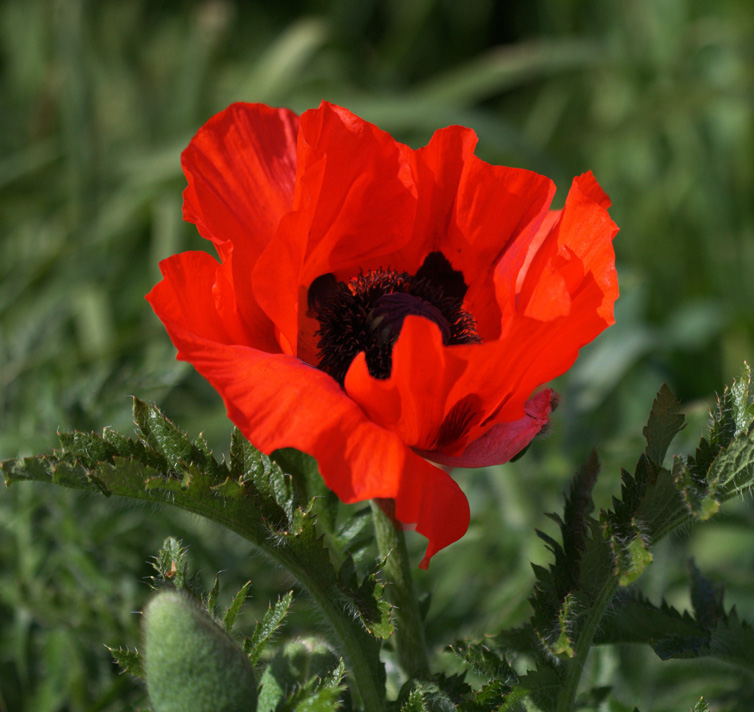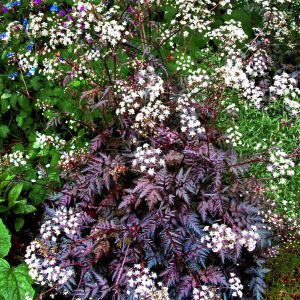- 1-9 pkts $4.50
- 10 pkts FREE
- Express post $12
Papaver orientale nana ‘Allegro’
DWARF ALLEGRO ORIENTAL POPPY
Huge silken cups of scarlet-red with black hearts, but produced on dwarf, compact Papaver orientale nana ‘Allegro’.
So flopping is not a problem.
But the silken summer blooms are just as spectacularly, outrageously beautiful as all the other perennial Oriental Poppies.
And although the plant is a compact dwarf, the blooms are full size, flamboyantly huge.
Extended season of interest
But the season of interest extends well beyond spectacular flowers with Papaver orientale nana ‘Allegro’.
You will find the plump buds are a real design feature before blooming, and fascinating as the silken petals peep, then slowly unfurl.
Then architectural seed pods follow the stunning flowers, and are also highly prized by floral artists.
The foliage clump is neat, symmetrical and low growing. So the foliage is a textural garden asset even when not in flower.
Hardy despite their exotic beauty
Oriental Poppies are not particularly thirsty plants, despite their exotic looks and huge flowers.
Plus they are also fully frost hardy, and will tolerate a range of soils. They are not difficult to please.
Good garden companions
Plant Oriental Poppies with autumn blooming stunners like Perovskia, Echinacea or Rudbeckia to take over from them.
Then the one spot provides spectacular flowering over a long season from spring to autumn end.
Our Poppy’s foliage is just a neat, low clump in autumn while the autumn companions strut their stuff with colour.
Hardy, resilient & long lived
If your Oriental Poppies disappear underground in the hottest part of summer – do not panic.
This summer dormancy is perfectly normal in heat. They will be back again with an even bigger and better clump at the start of autumn.
Oriental Poppies are hardy, resilient, and very long lived clumps once established in their spot. So please leave them in your will to your grandchildren.
They can tolerate soils with low fertility.
Though generous fertilizer and compost will produce even more massive blooms.
Sumptuous cut flowers
Even one Oriental Poppy in a vase is a show stopper. While several will stop you in your tracks.
Cut them either early in the morning, or at evening, just as the buds are about to open.
Sear the ends of the stems with a match or gas flame before putting straight into cool water. This will give Papaver orientale ‘Beauty of Livermere’ blooms a longer vase life.
Remove the outer green calyx from around the unfurling petals for even further flower life.
Hardy perennial clump. 40cm H x 45cm W.
SEED SOWING ADVICE: QUICK & EASY
Sow seeds at any time in punnets indoors / or sow in garden in autumn or spring.
Sow seed thinly onto the surface of good quality seed raising mix and lightly sprinkle with mix or river sand. Perennial poppies need light to germinate (annual poppies need the dark).
So Papaver orientale nana ‘Allegro’ requires good light for optimum germination.
Keep moist but not wet in a well-lit position.
Temperatures of 16-20°C are optimum for rapid germination.
Seed germinates in 10-30 days approx.
SEED COUNT: 120 seeds per pack approx.
GROWING: Papaver orientale nana ‘Allegro’
– Height with flowers: 40cm. approx.
– Width: 45cm. approx
– Position: Full Sun to Part Shade. Full Sun in cold districts, but in hotter positions they also happily enjoy some hours of shade, if it is well lit. Oriental Poppies are heat tolerant, as they will have a short summer dormancy if it turns very hot. (Important not think they have died and dig them out if they have a little rest over the hottest period – this is perfectly normal. They will return from underground as autumn begins). Because they are native to places with very hot summers, they have adapted to cope with it by going dormant when the heat climbs too far. Also because of their native range, they relish a very cold or frosty winter snap.
Where to plant
– Soil: Must have good drainage, as the strong fleshy roots will rot in soggy soil. Can thrive in all soil types from sandy through average garden loam to clay based soils. Clay based soils should be opened up, and sandy or rocky soils should have organic matter added. They grow happily in soils with a pH on either the acid or alkaline lime side of neutral
– Frost: Fully frost hardy, even in hard frosts to well below -10C. They shrug off frosts.
– Growth: Stout perennial clump which can go summer dormant in high heat. Foliage is a low growing neat, symmetrical clump of large decorative leaves.
– Care: Low maintenance. with little work to do other than feeding.
Other benefits
– Beneficial for wildlife: Bees are as besotted by the huge flowers as we are. They gather so much pollen, they can hardly fly with their bulging pollen sacks. Interestingly the pollen is black or purple.
Butterflies are also fed by the flowers.
If you leave the decorative seed heads to dry on the plant, the small seed eating birds will thank you for such well stocked larders. Each pod produces countless seeds. Do not worry, Oriental Poppies are in no way invasive.
– Deer & Rabbit resistant: Fortunately rabbits and deer don’t seem to like their hairy, whiskery leaves. Just as well, as a gardener could turn very nasty if they ate my treasured Oriental Poppies.
– Fragrance: Sadly none, but the blooms are so dazzling, you don’t notice the lack of scent.
– Origin: Native to Turkey, Armenia and Iran where they grow on rocky slopes, hence their love of good drainage.
Click here for Nursery Open Days & Open Gardens Information
https://www.gardivalia.com.au/open-gardens
Click here to go back to Seeds Shop
https://www.seedscape.net.au/shop/
Related products
-
Add to WishlistAlready In WishlistAdd to Wishlist
-
Add to WishlistAlready In WishlistAdd to Wishlist
-
Add to WishlistAlready In WishlistAdd to Wishlist
-
Add to WishlistAlready In WishlistAdd to Wishlist





